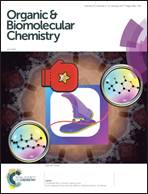Systematic study of constraints imposed by modified nucleoside triphosphates with protein-like side chains for use in in vitro selection†
Abstract
Successful selection of modified DNAzymes depends on the potential for modified nucleoside triphosphates (dNTPs) to replace their unmodified counterparts in enzyme catalyzed primer extension reactions and, once incorporated, to serve as template bases for information transfer prior to PCR amplification. To date, the most densely modified DNAzymes have been selected from three modified dNTPs: 8-histaminyl-deoxyadenosine (dAimTP), 5-guanidinoallyl-deoxyuridine (dUgaTP), and 5-aminoallyl-deoxycytidine (dCaaTP) to provide several RNA-cleaving DNAzymes with greatly enhanced rate constants compared to unmodified counterparts. Here we report biophysical and enzymatic properties of these three modified nucleosides in the context of specific oligonucleotide sequences to understand how these three modified nucleobases function in combinatorial selection. The base-pairing abilities of oligonucleotides bearing one or three modified nucleosides were investigated by thermal denaturation studies and as templates for enzymatic polymerization with both modified and unmodified dNTPs. While we address certain shortcomings in the use of modified dNTPs, we also provide key evidence of faithful incorporation and enzymatic read-out, which strongly supports their continued use in in vitro selection.



 Please wait while we load your content...
Please wait while we load your content...